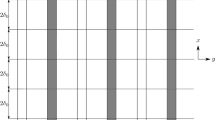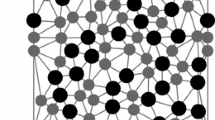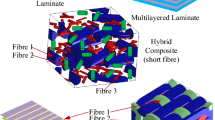Abstract
Three different models with increased complexity to study the effects of hybridization on the tensile failure of hybrid composites are proposed. The first model is a model for dry bundles of fibres based on the statistics of fibre strength. The second is a model for composite materials based on the multiple fragmentation phenomenon. Lastly, a micromechanical numerical model is developed that considers a random distribution of fibres and takes into account the stochastic nature of fibre strength. This study aims to understand the controlling factors that lead to pseudo-ductility, as well as establish the sequence of failure mechanisms in hybrid composites under tensile loadings.






















Similar content being viewed by others
References
Arteiro A, Catalanotti G, Melro A, Linde P, Camanho P (2014) Micro-mechanical analysis of the in situ effect in polymer composite laminates. Compos Struct 116:827–840. doi:10.1016/j.compstruct.2014.06.014
Bažant Z, Oh B (1983) Crack band theory for fracture of concrete. Matériaux et Construction 16(3):155–177. doi:10.1007/BF02486267
Benzeggagh M, Kenane M (1996) Measurement of mixed-mode delamination fracture toughness of unidirectional glass/epoxy composites with mixed-mode bending apparatus. Compos Sci Technol 56(4):439–449. doi:10.1016/0266-3538(96)00005-X
Curtin W (1991) Exact theory of fibre fragmentation in a single-filament composite. J Mater Sci 26(19):5239–5253. doi:10.1007/BF01143218
Curtin WA, Takeda N (1998) Tensile strength of fiber-reinforced composites: II. Application to polymer matrix composites. J Compos Mater 32(22):2060–2081
Fiedler B, Hojo M, Ochiai S, Schulte K, Ando M (2001) Failure behavior of an epoxy matrix under different kinds of static loading. Compos Sci Technol 61(11):1615–1624
Foray G, Descamps-Mandine A, R’Mili M, Lamon J (2012) Statistical flaw strength distributions for glass fibres: correlation between bundle test and afm-derived flaw size density functions. Acta Mater 60(9):3711–3718
Fukuda H (1984) An advanced theory of the strength of hybrid composites. J Mater Sci 19(3):974–982. doi:10.1007/BF00540468
Ibnabdeljalil M, Curtin W (1997) Strength and reliability of fiber-reinforced composites: localized load-sharing and associated size effects. Int J Solids Struct 34(21):2649–2668. doi:10.1016/S0020-7683(96)00179-5
Jr LM, Dai G (2014) Hybrid carbon/glass fiber composites: micromechanical analysis of structure-damage resistance relationships. Comput Mater Sci 81:630–640. doi:10.1016/j.commatsci.2013.08.024
Kelly A, Tyson W (1965) Tensile properties of fibre-reinforced metals: copper/tungsten and copper/molybdenum. J Mech Phys Solids 13(6):329–350. doi:10.1016/0022-5096(65)90035-9
Martínez X (2008) Micro-mechanical simulation of composite materials using the serial/parallel mixing theory. PhD thesis, Departament de Resistència de Materials i Estructures a l’Enginyeria (RMEE)–UPC. Director: Sergio Oller
Melro A, Camanho P, Pinho S (2008) Generation of random distribution of fibres in long-fibre reinforced composites. Compos Sci Technol 68(9):2092–2102. doi:10.1016/j.compscitech.2008.03.013
Melro A, Camanho P, Pires FA, Pinho S (2013) Micromechanical analysis of polymer composites reinforced by unidirectional fibres: part I—constitutive modelling. Int J Solids Struct 50(11–12):1897–1905. doi:10.1016/j.ijsolstr.2013.02.009
Melro A, Camanho P, Pires FA, Pinho S (2013) Micromechanical analysis of polymer composites reinforced by unidirectional fibres: part II—micromechanical analyses. Int J Solids Struct 50(11–12):1906–1915. doi:10.1016/j.ijsolstr.2013.02.007
Rajan VP, Curtin WA (2015) Rational design of fiber-reinforced hybrid composites: a global load sharing analysis. Compos Sci Technol 117:199–207. doi:10.1016/j.compscitech.2015.06.015
Scott A, Sinclair I, Spearing S, Thionnet A, Bunsell A (2012) Damage accumulation in a carbon/epoxy composite: comparison between a multiscale model and computed tomography experimental results. Compos A 43(9):1514–1522. doi:10.1016/j.compositesa.2012.03.011
Scott A, Sinclair I, Spearing S, Thionnet A, Bunsell A (2012) Damage accumulation in a carbon/epoxy composite: comparison between a multiscale model and computed tomography experimental results. Compos A 43(9):1514–1522. doi:10.1016/j.compositesa.2012.03.011
Simulia DS (2012) Abaqus 6.12 documentation. Providence, Rhode Island, US
Soden P, Hinton M, Kaddour A (1998) Lamina properties, lay-up configurations and loading conditions for a range of fibre-reinforced composite laminates. Compos Sci Technol 58(7):1011–1022. doi:10.1016/S0266-3538(98)00078-5
Swolfs Y, Gorbatikh L, Verpoest I (2014) Fibre hybridisation in polymer composites: a review. Compos A 67:181–200. doi:10.1016/j.compositesa.2014.08.027
Swolfs Y, McMeeking R, Rajan V, Zok F, Verpoest I, Gorbatikh L (2015) Global load-sharing model for unidirectional hybrid fibre-reinforced composites. J Mech Phys Solids 84:380–394. doi:10.1016/j.jmps.2015.08.009
Swolfs Y, McMeeking RM, Verpoest I, Gorbatikh L (2015b) The effect of fibre dispersion on initial failure strain and cluster development in unidirectional carbon/glass hybrid composites. Compos A 69:279–287. doi:10.1016/j.compositesa.2014.12.001
Swolfs Y, Morton H, Scott A, Gorbatikh L, Reed P, Sinclair I, Spearing S, Verpoest I (2015) Synchrotron radiation computed tomography for experimental validation of a tensile strength model for unidirectional fibre-reinforced composites. Compos A 77:106–113. doi:10.1016/j.compositesa.2015.06.018
Tanaka F, Okabe T, Okuda H, Kinloch IA, Young RJ (2014) Factors controlling the strength of carbon fibres in tension. Compos A 57:88–94. doi:10.1016/j.compositesa.2013.11.007
Turon A, Costa J, Maimí P, Trias D, Mayugo J (2005) A progressive damage model for unidirectional fibre-reinforced composites based on fibre fragmentation. Part I: formulation. Compos Sci Technol 65(13):2039–2048. doi:10.1016/j.compscitech.2005.04.012
Varna J, Berglund L, Ericson M (1997) Transverse single-fibre test for interfacial debonding in composites: 2. Modelling. Compos A 28(4):317–326. doi:10.1016/S1359-835X(96)00125-X
Weibull W (1951) A statistical distribution function of wide applicability. J Appl Mech Trans ASME 58(7):1001–1010
Zweben C (1977) Tensile strength of hybrid composites. J Mater Sci 12(7):1325–1337. doi:10.1007/BF00540846
Acknowledgments
The first and last authors would like to acknowledge the support from FCT and LAETA under the Project UID/EMS/50022/2013. M.A. Bessa and W.K. Liu would like to acknowledge the support through a subcontract from the Ford Motor Company with funding from the U.S. Department of Energys Office of Energy Efficiency and Renewable Energy (EERE), under Award Number DE-EE0006867, as well as the support by the Air Force Office of Scientific Research under the Award Number FA9550-14-1-0032.
Author information
Authors and Affiliations
Corresponding author
Rights and permissions
About this article
Cite this article
Tavares, R.P., Melro, A.R., Bessa, M.A. et al. Mechanics of hybrid polymer composites: analytical and computational study. Comput Mech 57, 405–421 (2016). https://doi.org/10.1007/s00466-015-1252-0
Received:
Accepted:
Published:
Issue Date:
DOI: https://doi.org/10.1007/s00466-015-1252-0




